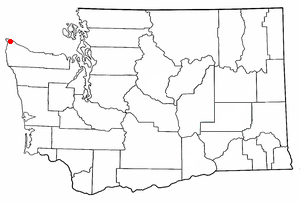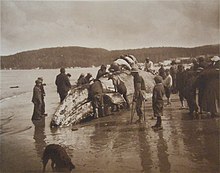Neah Bay
| Neah Bay | |
|---|---|
|
Location in Washington
|
|
| Basic data | |
| State : | United States |
| State : | Washington |
| County : | Clallam County |
| Coordinates : | 48 ° 22 ′ N , 124 ° 37 ′ W |
| Time zone : | Pacific ( UTC − 8 / −7 ) |
| Residents : | 865 (as of 2010) |
| Population density : | 141.8 inhabitants per km 2 |
| Area : | 6.1 km 2 (approx. 2 mi 2 ) of which 6.1 km 2 (approx. 2 mi 2 ) is land |
| Height : | 2 m |
| FIPS : | 53-48295 |
| GNIS ID : | 1512497 |
Neah Bay is a place in northwest Washington state . It had 794 inhabitants in 2000 and 865 in 2010. The statistics agency considers it a census-designated place in the Makah reservation in Clallam County . In 2010, 181 families lived there. Of the residents, 12.1% were recorded as white, 0.2% as black, 5.4% as Latinos and 9.7% belonged to two or more races. 77.1% were counted among the Indians designated as Native Americans, almost exclusively Makah. These belong to the Nuu-chah-nulth , whose other tribes live exclusively on the Canadian Vancouver Island .
history
The name of the place goes back to the Makah chief Dee-ah, as pronounced it by the neighboring Klallam , who belong to the coastal Salish . The name of the Makah, who called themselves “Kwih-dich-chuh-aht” (Qʷidiččaʔa · tx̌), comes from the Klallam. The place took his name from the bay that bore his name. Robert Haswell from Boston appeared in 1789 and described the place Neah Bay for the first time, although it did not yet have that name.
In 1790 Manuel Quimper took possession of the bay for Spain and named it in honor of the Viceroy of New Spain Alonso Núñez de Haro y Peralta Bahía de Núñez Gaona . In 1792 Salvador Fidalgo had a fortified trading post built on the bay, but he soon had to abandon it. In Neah Bay itself there were conflicts with the Spanish commander, who already summarized the assessment repertoire of most Europeans by describing the Makah as "warlike, devious and thieving" - apparently without any sense of the perspective of those affected by their harsh military action . Meanwhile, George Vancouver mapped the bay without making contact with the Makah or the Spanish. American traders called the bay Poverty Cove .
At the end of the 18th century, epidemics brought in by Europeans also reached the Makah, the number of which fell dramatically. 1805–1806 their number was estimated at around 2,000, in 1853 only 500. The Observer of Indians James Swan counted exactly 654 Makah in 1861, in 1905 only 435 were counted, in 1937 only 407.
In 1841, an American expedition led by Charles Wilkes mapped the area and named the bay Scarborough Harbor - in honor of Captain James Scarborough of the Hudson's Bay Company , who had supported the expedition. The name "Neah" appears for the first time in Wilkes' map, even though it also referred to the Waadah Island in the bay . The bay was first named "Neeah Bay" by Captain Henry Kellett in 1847. In 1833 the Japanese were stranded in the bay, in 1840 the Russians.
In 1846 the US-UK Border Treaty brought the Makah area to the US. On January 31, 1855, Washington Territory Governor Isaac Ingalls Stevens negotiated the Treaty of Neah Bay . In return for preserving their rights to live, hunt and collect, the Makah renounced 300,000 acres of land, their reservation now only comprised 27,265 acres .
An Indian agent was now sitting in Neah Bay ; In 1862 Henry A. Webster extended the reservation for a limited period, in 1869 he successfully requested permanent enlargement. But the Makah resisted plans to turn them into farmers. Every now and then there were open conflicts with neighboring tribes, but also with Ditidaht and Sooke on Vancouver Island, Canada . Similar to the Nuu-chah-nulth in Canada, the Makah were proselytized, their children placed in schools that deprived them of the use of their language and the basics of their culture. Therefore, the Makah language was almost extinct. A police force existed on the reservation and in 1882 an Indian court was established.
Initially, the Makah managed to hire white ship owners and hunt seals (from around 1880). At the end of the 19th century they had their own ships and hired white sealers. They founded the Neah Bay Fur Sealing Company in 1880 and chartered the ship Lottie in Port Townsend . Eventually, Chief James Claplanhoo bought the ship, three more schooners were purchased, finally the Discovery in Victoria . In 1886 Chief Peter Brown bought the schooner Champion . However, their ability to develop their own fishing industry has been thwarted by legal restrictions. Privatization of the tribal area began in 1907, with each makah receiving only ten acres .
In 1929, the Neah Bay Dock Company , a subsidiary of the Puget Sound Navigation Company , owned a hotel in Neah Bay. In 1931 the relative isolation was lifted by the completion of a coastal road.
The Indian Shaker Church , founded by John Slocum , also found followers in Neah Bay, but in 1927 there was a split over the question of the use of the Bible in worship. William Kitsap, who also rejected the bishopric election for life, called for a separate meeting in Neah Bay, while his opponents gathered in Oakville. The assembly elected two bishops. The dispute was not settled until 1945 by the Snohomish County Superior Court.
The Makah have been teaching their own language again since the early 1920s. In 1934 they approved the Indian Reorganization Act . This enabled limited self-government under elected leaders. Most importantly, the Trust Land remained protected from alienation. In this way they prevented the best properties and trapping sites from being sold. In 1936 and 1937 they were given a constitution and a charter. In 1952 some of the elders founded a school in which traditional techniques such as working canoes could be learned.
In the 1950s, disputes with the government over fishing and seal fishing rights ensued. The Makah have been deprived of their rights since the countries bordering the Pacific imposed fishing bans without providing compensation. In 1984 they got Waadah and Tatoosh Island back to compensate .
The Coast Guard has a base in Neah Bay, and a warning system has already saved 41 vessels since 1999.
literature
- Patricia Pierce Erikson, Helma Ward, Kirk Wachendorf, Janine Bowechop: Voices of a Thousand People: The Makah Cultural and Research Center , University of Nebraska Press, 2005, ISBN 978-0-8032-6756-5
- Robert H. Ruby, John A. Brown: A Guide to the Indian Tribes of the Pacific Northwest , University of Oklahoma Press 1992, pp. 125-128.
Web links
- Makah website
- Makah Museum in Neah Bay
- University of Washington Libraries Digital Collections - The Pacific Northwest Olympic Peninsula Community Museum
- Makah Cultural and Research Center Online Museum Exhibit History and culture of the Makah tribe.
Remarks
- ^ Edmond S. Meany: Origin of Washington Geographic Names , in: The Pacific Northwest Quarterly X-XI (1921) 279f.
- ^ Mary Stiles Kline, George Albert Bayless: Ferryboats. A Legend on Puget Sound , Bayless Books, 1983, p. 182.
- ↑ Washington State Department of Ecology ( Memento of the original from January 26, 2012 in the Internet Archive ) Info: The archive link was inserted automatically and has not yet been checked. Please check the original and archive link according to the instructions and then remove this notice. .



